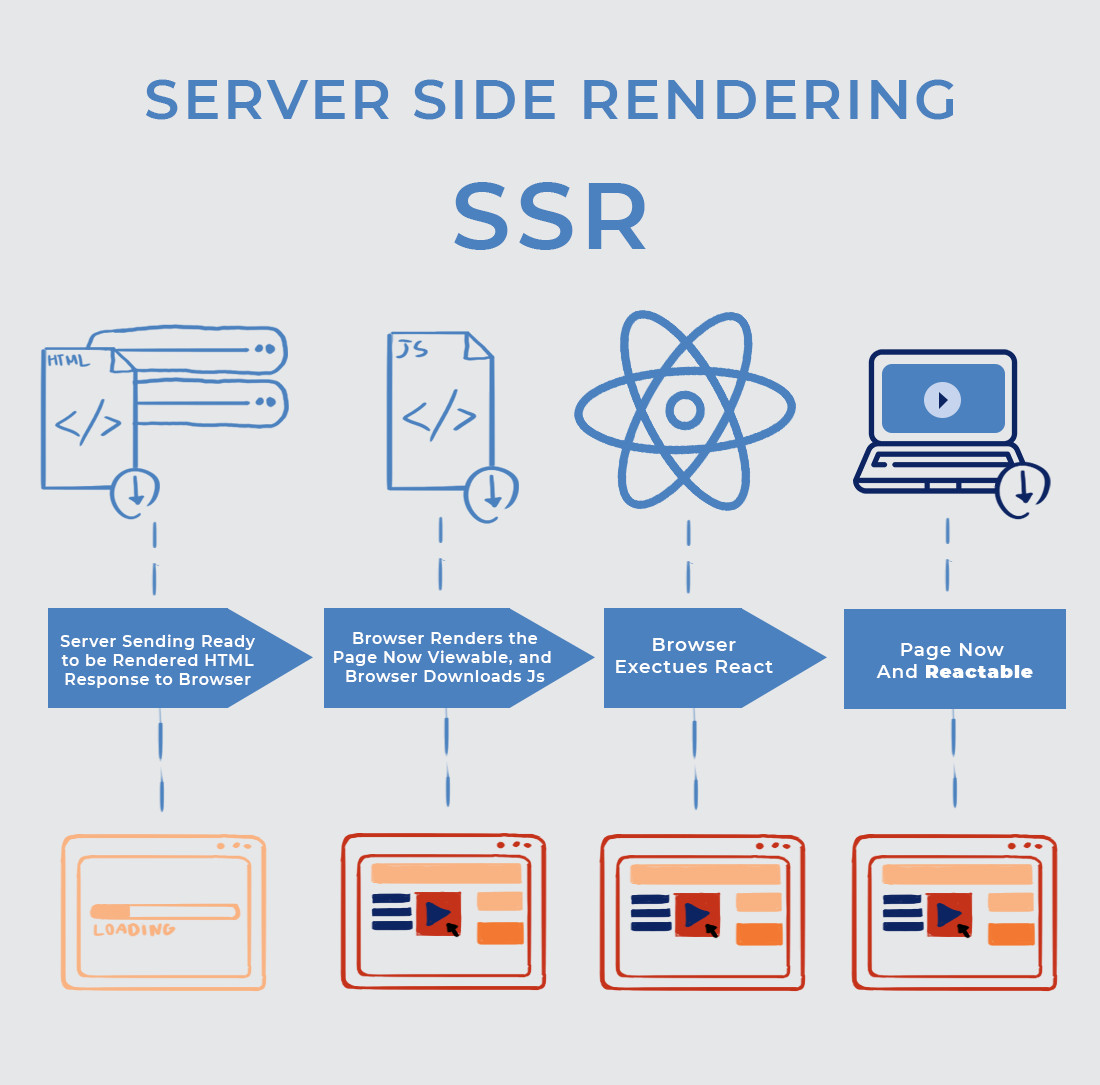Server-side Rendering (SSR) is a technique used in web development where a web page is rendered on the server instead of in the user’s web browser. This means that when a user requests a page, the server processes the request and sends back a fully rendered HTML page. The user’s browser then simply displays this pre-rendered page. This approach contrasts with client-side rendering, where the browser downloads a minimal HTML page along with JavaScript code, and then the JavaScript is executed in the browser to dynamically generate and render the full page content.
 Diagram illustrating the server-side rendering process flow
Diagram illustrating the server-side rendering process flow
Delving Deeper into Server-Side Rendering
Server-side rendering works by intercepting the initial request from a user’s browser. Instead of sending a blank page and relying on the browser to build the content, the server executes the application code. This process involves fetching data, compiling templates, and generating the final HTML structure of the webpage. Once this rendering process is complete, the server delivers the fully formed HTML page to the client’s browser.
This pre-rendered HTML is immediately displayed to the user, offering a faster initial load time as the browser doesn’t need to wait for JavaScript to download and execute before seeing content. Subsequently, modern SSR implementations often “hydrate” the page in the browser. Hydration is the process where the JavaScript framework on the client-side takes over the static HTML rendered by the server and makes it interactive. This allows for the benefits of SSR for initial load and SEO, combined with the rich interactivity of a Single Page Application (SPA).
Popular JavaScript frameworks offer robust solutions for implementing server-side rendering. These include Next.js for React, Nuxt.js for Vue.js, Angular Universal for Angular, and others like Express.js for backend rendering solutions and frameworks like NestJS built for scalable server-side applications. These frameworks simplify the complexities of SSR and provide tools and configurations to efficiently render applications on the server.
Advantages of Server-Side Rendering
Server-side rendering provides several key benefits, making it a valuable technique for web developers:
- Improved User Experience (UX): One of the most significant advantages is faster perceived loading times. Users see content rendered almost instantly, especially on the initial page load. This leads to a smoother and more engaging user experience, reducing bounce rates and improving overall satisfaction. Websites that utilize server-side rendering tend to feel snappier and more responsive from the user’s perspective.
- Enhanced Search Engine Optimization (SEO): Search engine crawlers, like Googlebot, can easily index server-rendered content. Because the server delivers a fully rendered HTML page, search engines can efficiently crawl and understand the content of the page without needing to execute JavaScript. This is crucial for SEO, as it ensures that search engines can properly index your website’s content, leading to better search rankings.
- Better Performance for Low-Powered Devices and Slow Connections: Server-side rendering shifts the rendering burden from the client’s browser to the server. This is particularly beneficial for users with older devices or slow internet connections. These users can experience a functional website even if their devices or networks struggle with heavy client-side JavaScript execution.
- Enhanced Social Sharing: When web pages are shared on social media platforms, server-rendered pages often provide richer previews and ensure that social media crawlers can properly access and display content. This leads to more appealing and informative social sharing experiences.
Disadvantages of Server-Side Rendering
While server-side rendering offers numerous advantages, it’s important to consider potential drawbacks:
- Increased Server Load: SSR can put a higher load on servers. Rendering pages on the server requires more server resources compared to simply serving static files and letting the client handle rendering. This can lead to increased server costs, especially for websites with high traffic volume.
- Development Complexity: Implementing server-side rendering can add complexity to the development process. Developers need to manage code execution on both the server and the client, which can introduce challenges in terms of code sharing, debugging, and deployment.
- Potential for Slower Time To First Byte (TTFB): While perceived load time improves, the Time To First Byte (TTFB) – the time it takes for the browser to receive the first byte of data from the server – might be slightly longer with SSR. This is because the server needs to perform the rendering process before sending the response. However, this is often offset by the faster perceived load time and improved user experience.
- Compatibility Issues with Client-Side Libraries: Some JavaScript libraries and components are designed primarily for client-side rendering and might require adjustments or workarounds to function correctly in a server-rendered environment.
Server-Side Rendering vs. Client-Side Rendering: Key Differences
The choice between server-side rendering and client-side rendering depends on the specific needs and priorities of a project. Here’s a table summarizing the key differences:
| Feature | Server-Side Rendering (SSR) | Client-Side Rendering (CSR) |
|---|---|---|
| Rendering Location | Server | Client Browser |
| Initial Load Time | Faster Perceived Load | Slower Perceived Load |
| SEO Friendliness | Excellent | Can be Challenging |
| Server Load | Higher | Lower |
| Client Load | Lower | Higher |
| Interactivity | Can require Hydration | Directly Interactive |
| Complexity | Higher | Lower |
| TTFB | Potentially Higher | Potentially Lower |
When to Use Server-Side Rendering
Server-side rendering is particularly beneficial in scenarios where:
- SEO is a Priority: For websites where search engine ranking is crucial, such as e-commerce sites, blogs, and content-heavy platforms.
- Initial Load Time Matters Most: When providing a fast initial user experience is paramount, especially for users on slow connections or mobile devices.
- Content is Primarily Static: For websites with content that doesn’t change frequently or requires minimal real-time updates, SSR can be highly effective.
In conclusion, server-side rendering is a powerful technique for enhancing web application performance, SEO, and user experience. While it introduces some complexity and server-side considerations, the benefits often outweigh the drawbacks, particularly for content-driven and SEO-sensitive websites. Understanding the nuances of SSR and its comparison to client-side rendering allows developers to make informed decisions about the optimal rendering strategy for their projects.

